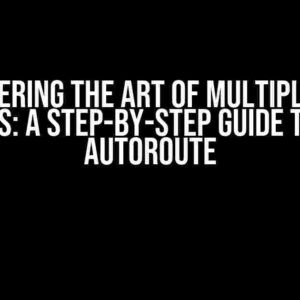Are you tired of dealing with read-only user timestamps in Keycloak? Do you want to take control of your user management and make changes to timestamps as needed? Look no further! In this article, we’ll explore the ins and outs of creating user timestamps in Keycloak that are not read-only, giving you the flexibility and control you need to manage your users effectively.
Understanding Keycloak User Timestamps
Before we dive into creating non-read-only user timestamps, let’s take a step back and understand what user timestamps are in Keycloak. In Keycloak, user timestamps refer to the date and time when a user account was created or last updated. These timestamps are essential for tracking user activity, monitoring account changes, and maintaining a secure environment.
By default, Keycloak sets user timestamps to read-only, which means that they cannot be modified manually. While this provides an added layer of security, it can be limiting for administrators who need to make changes to user accounts.
Why Do I Need Non-Read-Only User Timestamps?
There are several scenarios where having non-read-only user timestamps can be beneficial:
-
Merging user accounts: When merging two user accounts, you may need to update the timestamps to reflect the merged account’s creation date.
-
Updating user information: If you need to update a user’s information, such as their email or username, you may want to update the timestamp to reflect the change.
-
Auditing and compliance: In certain industries, having non-read-only user timestamps can be essential for auditing and compliance purposes, such as tracking changes to user accounts for regulatory requirements.
Creating Non-Read-Only User Timestamps in Keycloak
So, how do you create non-read-only user timestamps in Keycloak? It’s easier than you think! Follow these step-by-step instructions:
-
Log in to your Keycloak instance as an administrator.
-
Navigate to the
Userstab and select the user account you want to modify. -
Click on the
Editbutton to open the user account settings. -
In the
User Settingspage, click on theAttributestab. -
Scroll down to the
CreatedandModifiedfields and click on theEditbutton next to each field. -
In the
Field Editorwindow, toggle theRead-onlyswitch to theOffposition for both theCreatedandModifiedfields. -
Click
Saveto update the user account settings.
That’s it! You have now successfully created non-read-only user timestamps in Keycloak.
Best Practices for Managing User Timestamps
While having non-read-only user timestamps can be beneficial, it’s essential to follow best practices to maintain data integrity and security:
-
Only grant access to authorized administrators to modify user timestamps.
-
Use auditing and logging to track changes to user timestamps.
-
Implement role-based access control (RBAC) to restrict access to user timestamp modifications.
-
Document changes to user timestamps and maintain an audit trail.
Programmatic Access to User Timestamps
In addition to manual modifications, Keycloak provides programmatic access to user timestamps through its REST API. This allows you to automate user account management and integrate with other systems.
curl -X PATCH \
https://your-keycloak-instance.com/auth/admin/realms/your-realm/users/your-user-id \
-H 'Authorization: Bearer YOUR_ACCESS_TOKEN' \
-H 'Content-Type: application/json' \
-d '{"attributes":{"CREATED":"2022-01-01T12:00:00.000Z","MODIFIED":"2022-01-01T12:00:00.000Z"}}'
In the above example, we’re using the Keycloak REST API to update the CREATED and MODIFIED timestamps for a user account.
| HTTP Method | Endpoint | Description |
|---|---|---|
| PATCH | /users/{user-id} | Update a user account, including timestamps. |
| GET | /users/{user-id} | Retrieve a user account, including timestamps. |
Conclusion
In conclusion, creating non-read-only user timestamps in Keycloak is a straightforward process that can provide administrators with greater control over user account management. By following best practices and programmatic access to user timestamps, you can ensure data integrity and security while automating user account management.
Remember, with great power comes great responsibility. Use your newfound ability to manage user timestamps wisely and maintain a secure Keycloak environment.
We hope you found this article informative and helpful. If you have any questions or need further assistance, please don’t hesitate to reach out.
Frequently Asked Question
Get the inside scoop on Keycloak’s create user timestamps not being read-only!
Why does Keycloak allow modifying user creation timestamps?
By design, Keycloak allows administrators to modify user creation timestamps to accommodate various use cases, such as backdating user accounts for auditing or compliance purposes. This flexibility is intentional, but it’s essential to ensure that your use case aligns with Keycloak’s security and integrity principles.
How can I prevent users from modifying their own creation timestamps?
To restrict users from modifying their own creation timestamps, you can create a custom role with limited permissions or use Keycloak’s built-in `realm-management` role, which grants administrators control over user management. This way, only authorized personnel can edit user creation timestamps.
Are there any security implications of allowing timestamp modifications?
While allowing timestamp modifications can be useful, it’s crucial to ensure that your system doesn’t rely solely on creation timestamps for security-critical decisions, such as access control or audit logging. Implement additional safeguards, like digital signatures or tamper-evident logs, to maintain the integrity of your system.
Can I use a custom plugin to enforce read-only timestamps?
Yes, you can develop a custom plugin to enforce read-only timestamps using Keycloak’s extensibility features, such as SPI (Service Provider Interface) or custom authentication scripts. This will allow you to tailor the behavior to your specific use case and security requirements.
Are there any plans to make timestamps read-only by default in future Keycloak releases?
While there are no immediate plans to change the default behavior, Keycloak’s development roadmap is influenced by community feedback and security best practices. As the product evolves, we may revisit this feature to improve security and compliance. Stay tuned for updates and contribute your thoughts to the Keycloak community!


